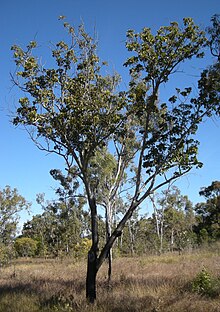Clerodendrum floribundum, known as the lolly bush or smooth clerodendrum, is a shrub or tree found in Australia and New Guinea. Its habitat is in or at the margins of coastal rainforests, up to 300 metres above sea level. In Western Australia it grows in drier areas, such as rocky sites, gorges, cliffs, floodplains and creek beds.[4]
| Lolly bush | |
|---|---|

| |
| At Mount Archer National Park, Queensland | |
| Scientific classification | |
| Kingdom: | Plantae |
| Clade: | Tracheophytes |
| Clade: | Angiosperms |
| Clade: | Eudicots |
| Clade: | Asterids |
| Order: | Lamiales |
| Family: | Lamiaceae |
| Genus: | Clerodendrum |
| Species: | C. floribundum
|
| Binomial name | |
| Clerodendrum floribundum | |
| Synonyms[3] | |
|
Siphonanthus floribundus | |
Description
editThe leaves may be drawn into a blunt tip, a prickle or a sharp tip. They are variable in shape, usually 4 to 15 cm long, and 2 to 6 cm wide. The young leaves are not as hairy as those of the related downy chance (Clerodendrum tomentosum). The generic term Clerodendrum is from the Greek, meaning 'lottery tree'. The term 'lottery' refers to an unsure possibility of a medicinal value from plants of this genus. The specific epithet floribundum refers to the abundance of flowers in showy heads. The fruit is a black drupe, growing on an enlarged red fleshy calyx. It appears glossy and succulent, giving rise to the common name 'lolly bush'.
Although usually a small tree, it has been recorded at 30 metres tall with a stem diameter of 30 cm at Booyong Flora Reserve, in northern New South Wales.[5] White fragrant flowers form in cymes between September and December.
Taxonomy
editThis species was first described in 1810 by the prolific Scottish botanist Robert Brown in his book Prodromus Florae Novae Hollandiae. Brown added the abbreviation "v.v." after the description, which stands for the Latin vide viva (seen alive), signifying that his description was based on material he collected himself.[6]: 511
Infraspieces
editSix varieties have been named in various publications,[2] as follows:
- Clerodendrum floribundum var. angustifolium
- Clerodendrum floribundum var. attenuatum
- Clerodendrum floribundum var. coriaceum
- Clerodendrum floribundum var. latifolium
- Clerodendrum floribundum var. medium
- Clerodendrum floribundum var. ovatum
Of these, as of June 2024[update], only the first, second and last are recognised in the Australian Plant Census,[7][8][9] only C. f. ovatum is recognised by Plants of the World Online,[3] all are disputed in Queensland Herbarium's Wildnet database,[10] the first, second, third and last are recognised by the Northern Territory Herbarium,[11] and the first, third and last are accepted by the Western Australian Herbarium.[12] It appears that no authority accepts the variety C. f. medium.
Distribution
editThere is some debate whether this plant is found in rainforests of the Illawarra. A.G.Floyd says it is found as far south as Batemans Bay and growing north to Cape York at the northernmost point of the continent, and then west through the Northern Territory and Western Australia.[13] However, the Royal Botanic Gardens, Sydney say records in the far southeast may not be accurate.[14]
Ecology
editThe leaves are host to the caterpillar of the fiery jewel butterfly.[citation needed]
Cultivation
editRegeneration is from fresh seeds or cuttings. It is an easy plant to grow, although it requires plenty of water.[citation needed]
Gallery
edit-
Leaves, Mount Keira, NSW
-
Underside of leaves, Cairns, Queensland
-
Flowers and buds
-
In flower at Royal Botanic Garden, Sydney, NSW
-
Flowers
-
Fruit
References
edit- ^ Botanic Gardens Conservation International (BGCI); IUCN SSC Global Tree Specialist Group. (2018). "Clerodendrum floribundum". IUCN Red List of Threatened Species. 2018: e.T136089490A136089492. doi:10.2305/IUCN.UK.2018-2.RLTS.T136089490A136089492.en. Retrieved 6 July 2024.
- ^ a b "Clerodendrum floribundum". Australian Plant Name Index (APNI). Centre for Australian National Biodiversity Research, Australian Government. Retrieved 6 July 2024.
- ^ a b c "Clerodendrum floribundum R.Br". Plants of the World Online. Royal Botanic Gardens, Kew. 2024. Retrieved 6 July 2024.
- ^ "Clerodendrum floribundum". Conservation and Land Management, Western Australia.
- ^ Floyd, Alexander G. (1990). Australian Rainforests in New South Wales. Vol. 2. Chipping Norton, Australia: Surrey Beatty & Sons (published 1990-08-31). p. 179. ISBN 0-949324-32-9. Retrieved 2010-12-28. (other publication details, included in citation)
- ^ Brown, Robert (1810). Prodromus florae Novae Hollandiae et Insulae Van-Diemen, exhibens characteres plantarum (in Latin). Vol. 1. London: R. Taylor and Associates. doi:10.5962/bhl.title.3678. Retrieved 6 July 2024.
- ^ "Clerodendrum floribundum var. angustifolium". Australian Plant Name Index (APNI). Centre for Australian National Biodiversity Research, Australian Government. Retrieved 6 July 2024.
- ^ "Clerodendrum floribundum var. attenuatum". Australian Plant Name Index (APNI). Centre for Australian National Biodiversity Research, Australian Government. Retrieved 6 July 2024.
- ^ "Clerodendrum floribundum var. ovatum". Australian Plant Name Index (APNI). Centre for Australian National Biodiversity Research, Australian Government. Retrieved 6 July 2024.
- ^ "Species profile—Clerodendrum floribundum". Queensland Department of Environment and Science. Queensland Government. 2024. Retrieved 6 July 2024.
- ^ Cowie I, Lewis D, et al. "Clerodendrum floribundum". FloraNT, Northern Territory Herbarium. Northern Territory Government, Darwin. Retrieved 6 July 2024.
- ^ Western Australian Herbarium (1998–2024). "Taxon Profile of Clerodendrum floribundum AUTHOR". Florabase—the Western Australian Flora. Department of Biodiversity, Conservation and Attractions, Government of Western Australia. Retrieved 6 July 2024.
- ^ Floyd, A. G. (2008). Rainforest Trees of Mainland South-eastern Australia (2nd, Revised ed.). Lismore, New South Wales: Terania Rainforest Publishing. p. 171. ISBN 978-0-958943-67-3. Retrieved 2010-12-28.
- ^ *"Clerodendrum floribundum". PlantNET - NSW Flora Online. Retrieved 2010-12-28.
